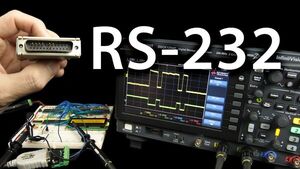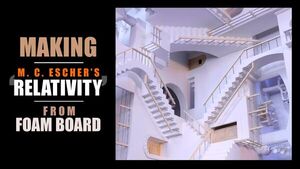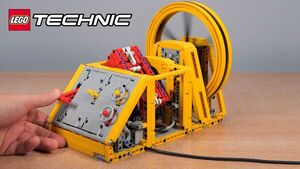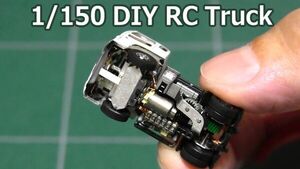2022-11-24 - Nº 395
Editorial
Esta é a Newsletter Nº 395 que se apresenta com o mesmo formato que as anteriores. Se gostar da Newsletter partilhe-a!
Todas as Newsletters encontram-se indexadas no link.
Esta Newsletter tem os seguintes tópicos:
Faz hoje anos que nascia, em 1912, o físico nuclear norte-americano Lyle B. Borst. Ele liderou a construção do Reactor de Investigação de Grafite (BGRR), no Laboratório Nacional de Brookhaven. Após o trabalho no Projecto Manhattan na II Guerra Mundial, organizou cerca de 1.300 cientistas, e falou perante o Congresso para manter a investigação atómica sob controlo civil, a fim de evitar uma corrida mundial ao armamento nuclear. Em 1946, com Karl Morgan, desenvolveu um crachá de filme para medir a exposição dos trabalhadores aos neutrões rápidos. O BGRR, concluído em 1949, foi o primeiro reactor construído exclusivamente para investigar a utilização da energia atómica em tempo de paz. No seu primeiro ano de funcionamento, Borst anunciou a produção de iodo radioactivo adequado para o tratamento do cancro da tiróide. Em 1952, ele explicou como o berílio-7 da fusão do hélio desencadeia super-novas.
Faz também hoje anos que nascia, em 1921, o químico norte-americano Robert L. Banks. Ele co-descobriu o polímero cristalino de polipropileno, com J. Paul Hogan. Foram designados pela Phillips Petroleum, em 1946, para investigar formas de tomar os produtos de gás natural propileno e etileno e transformá-los em componentes úteis da gasolina. Em 5 de Junho de 1951, as suas experiências utilizando catalisadores produziram polipropileno - agora utilizado em fibras para cordas, carpetes interiores e exteriores e plásticos. Bancos e Hogan descobriram também como fazer um novo polietileno de alta densidade, mais resistente ao calor do que o polietileno anteriormente existente. Além disso, os seus catalisadores produziram o novo polietileno a apenas algumas centenas de psi de pressão em vez do processo radical livre existente, que exigia pressões de até 30.000 psi.
Faz igualmente hoje anos que nascia, em 1921, o físico nuclear americano Herbert F. York. Ele iniciou a investigação científica em apoio à defesa nacional em 1943, quando começou a trabalhar em Oak Ridge, Tennessee, na separação electromagnética do urânio 235, como parte do Projecto Manhattan durante a II Guerra Mundial. Em 1952, tornou-se o primeiro director do Laboratório Lawrence Livermore. Saiu em Mar 1958 para se juntar ao Departamento de Defesa como cientista chefe da Agência de Projectos de Investigação Avançada, e rapidamente se tornou o director de investigação e engenharia do Departamento de Defesa (Dez. 1958). Regressou à Universidade da Califórnia em 1961, como chanceler e professor de Física. Foi negociador principal para a proibição total de testes durante a administração Carter.
Faz também hoje anos que nascia, em 1925, o engenheiro e físico holandês Simon van der Meer. Ele, em conjunto com o físico italiano Carlo Rubbia, descobriu a partícula W e a partícula Z ao colidir protões e antiprotões, para os quais ambos os homens partilharam o Prémio Nobel da Física. Estas partículas subatómicas (unidades de matéria menores que um átomo) transmitem a fraca força nuclear, uma das quatro forças fundamentais na natureza. A descoberta apoiou a teoria unificada do electroweak apresentada nos anos 70. Trabalhando no CERN na Suíça, Van der Meer melhorou a concepção dos aceleradores de partículas utilizados, produzindo colisões entre feixes de partículas subatómicas. Inventou um dispositivo que monitorizaria e ajustaria o feixe de partículas com campos magnéticos correctores, através de um sistema de "kickers" colocados em torno do anel do acelerador.
Faz igualmente hoje anos que nascia, em 1926, o físico norte-americano nascido na China Tsung-Dao Lee. Ele recebeu (com Chen Ning Yang) o Prémio Nobel da Física de 1957 pela sua "investigação penetrante" das violações do princípio da conservação da paridade (a qualidade da simetria de reflexão espacial das interacções das partículas subatómicas), o que levou a importantes descobertas sobre as partículas elementares. A conservação da paridade tinha sido anteriormente considerada como uma "lei" da natureza. (A paridade sustenta que as leis da física são as mesmas num sistema de coordenadas à direita do que num sistema à esquerda). A teoria foi posteriormente confirmada experimentalmente por Chien-Shiung Wu em observações de decadência beta.
Por fim, faz hoje anos que nascia, em 1944, o cientista atmosférico indiano Veerabhadran Ramanathan. Ele descobriu a "Nuvem Castanha Asiática" - camadas errantes de poluição atmosférica tão largas como um continente e mais profundas do que o Grand Canyon. As partículas escuras nestas nuvens castanhas podem reduzir a precipitação, secar a superfície do planeta, arrefecer os trópicos e reduzir a luz solar - Global Dimming. Em 1975, o Ramanathan foi o primeiro a demonstrar que os CFC são gases com efeito de estufa importantes. Os seus cálculos mostraram que cada molécula de CFC na atmosfera contribui mais para o efeito de estufa que mais de 10.000 moléculas de dióxido de carbono. Nos anos 80, liderou um estudo que descobriu numerosos gases vestigiais que contribuem para o aquecimento global, e um estudo da NASA que demonstrou que as nuvens tinham um efeito líquido de arrefecimento global no planeta".
Em 1639, Jeremiah Horrocks, astrónomo e sacerdote inglês, mediu um trânsito de Vénus, o primeiro de sempre a ser observado. Aplicando a previsão de Kepler de que em 1631, Vénus transitaria pelo Sol, Horrocks calculou que estes trânsitos não ocorreram isoladamente, mas em pares, com oito anos de diferença. Assim, Horrocks preparou o seu equipamento para o trânsito seguinte que tinha assim previsto para este dia. O seu simples telescópio foi montado numa trave de madeira, para que pudesse projectar uma imagem solar sobre um pedaço de papel marcado com um círculo graduado de seis polegadas. A partir disto, ele fez medições e calculou que o valor para o paralaxe solar era menor do que anteriormente registado, e assim concluiu que o Sol estava mais longe da Terra do que anteriormente se pensava.
Em 1859, The Origin of Species by Means of Natural Selection, o livro pioneiro de Darwin, foi publicado em Inglaterra para grande aclamação. O naturalista britânico Charles Darwin detalhou as provas científicas que tinha recolhido desde a sua viagem no Beagle, nos anos 1830. Ele apresentou a sua ideia de que as espécies são o resultado de uma evolução biológica gradual na qual a natureza encoraja, através da selecção natural, a propagação das espécies mais adequadas aos seus ambientes. Tinha sido levado a publicar nesta altura por Charles Lyell, que o aconselhou que Alfred Russel Wallace, um naturalista que trabalha no Bornéu, se aproximava das mesmas conclusões. Lyell acreditava que Darwin deveria publicar sem mais demora para estabelecer a prioridade.
Na Newsletter desta semana apresentamos diversas noticias, artigos científicos, projetos de maker e alguns vídeos interessantes. É apresentada a revistar MagPI nº 124 de Dezembro.
 João Alves ([email protected])
João Alves ([email protected])
O conteúdo da Newsletter encontra-se sob a licença  Creative Commons Attribution-NonCommercial-ShareAlike 4.0 International License.
Creative Commons Attribution-NonCommercial-ShareAlike 4.0 International License.
Novidades da Semana
Outras Notícias

NASA, ESA Reveal Tale of Death, Dust in Orion Constellation
"In a tale of cosmic proportions, the region is being transformed by the massive stars that live and die within it. A new image combining previously released data from three telescopes shows a region that includes the Orion Nebula, named after the mighty hunter from Greek mythology who was felled by a scorpion’s sting. But the story of how this dusty region came to be is just as dramatic. The Orion Nebula is located in the constellation Orion, which takes the appearance of a hunter raising a club and shield at an unseen target. Three stars in a line are together known as Orion’s belt; the region shown in the image aligns with another series of stars perpendicular to the belt, known as Orion’s sword. If you could see it in the sky, the region would appear about the size of the full moon." [...]

Nexperia releases ultrafast 650 V Recovery Rectifiers for automotive and industrial applications
"Nexperia, the expert in essential semiconductors, today announced the expansion of its portfolio of Clip-bonded FlatPower (CFP) packaged diodes for industrial and automotive applications. The latest additions include four 650 V, 1 A parts available in CFP3 and CFP5 packages intended for use in onboard chargers (OBC) and inverters for electric vehicles, power converters, PV inverters, and power supplies in industrial applications. Standard products include the PNU65010ER (CFP3) and PNU65010EP (CFP5) while AEC-Q101 qualified products include the PNU65010ER-Q (CFP3) and PNU65010EP-Q (CFP5). These automotive and industrial-grade rectifiers provide the optimal tradeoff between ultrafast soft switching behavior and low forward voltage drop to help minimize power losses in high-frequency applications. Their small CFP footprint saves board space (compared to SMA/B packaged devices), enabling reliable, high-density designs without compromising on electrical performance. These 650 V diodes are already being used in several designs of Tier 1 automotive and industrial suppliers." [...]
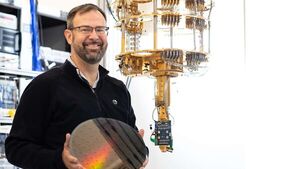
The Journey to Building a True Quantum Computer
"The past several years have been an exciting time in quantum computing. Billions of dollars have been invested, and there's no shortage of advocates and detractors. Activity and momentum across the quantum community continue to grow. For proof, there have been a lot of recent headlines about increased qubit counts, commercially viable systems, roadmaps and startups. Some claim true commercialization is just around the corner. Despite very exciting developments in the field, a fault-tolerant 1 million-plus qubit machine and true commercial uses for quantum computing are 10 to 15 years from reality." [...]

STMicroelectronics launches a new advanced 6-axis IMU with embedded sensor fusion and AI
"ST has introduced LSM6DSV16X, the flagship 6-axis inertial measurement unit (IMU) embedding ST’s Sensor Fusion Low Power (SFLP) technology, Artificial Intelligence (AI), and adaptive-self-configuration (ASC) for superior power optimization. The advanced architecture of the LSM6DSV16X enables sophisticated processing in the edge, making the device ideal for advanced 3D phone mapping, context awareness in laptops and tablets, reliable and precise gesture recognition for XR headsets, as well as always-on activity tracking. All the processing is done in the MEMS sensor itself, which also contains a triple sensing core to meet the differing needs of user-interface controls and optical/electronic image stabilization (OIS/EIS). The IC integrates an enhanced finite state machine (FSM), to detect fast events and custom gestures. In addition, the latest updates to ST’s innovative machine-learning core (MLC) raise the performance of inference algorithms such as human activity recognition. ST has published ready-to-use MLC and FSM algorithms on GitHub to help product designers cut time to market when implementing these advanced capabilities in new products." [...]
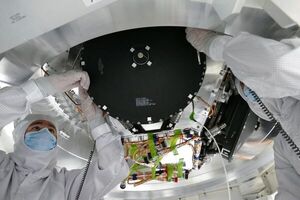
NASA’s Europa Clipper Gets Its Wheels for Traveling in Deep Space
"The enormous spacecraft that will head to Jupiter’s moon Europa uses four large reaction wheels to help keep it oriented. Just as NASA’s Mars rovers rely on robust wheels to roam the Red Planet and conduct science, some orbiters rely on wheels, too – in this case, reaction wheels – to stay pointed in the right direction. Engineers and technicians at NASA’s Jet Propulsion Laboratory in Southern California recently installed four reaction wheels on Europa Clipper, which will rely on them during its journey at Jupiter’s icy moon Europa. When NASA’s spacecraft heads through deep space, slips into orbit around Jupiter, and collects science observations while flying dozens of times by Europa, the wheels rotate the orbiter so that its antennas can communicate with Earth and its science instruments, including cameras, can stay oriented. Two feet wide and made of steel, aluminum, and titanium, the wheels spin rapidly to create torque that causes the orbiter to rotate in the opposite direction. Isaac Newton’s third law of motion also applies in deep space and explains the underlying phenomenon: For every action, there is an equal and opposite reaction." [...]

Samsung to make 3 nm chips for Nvidia, Qualcomm, IBM, Baidu
"Amid fierce industry competition, Samsung aims to overtake TSMC in 3-nanometer technology. Samsung Electronics Co., the world’s largest memory chipmaker, will make semiconductors with the industry’s most advanced 3-nanometer process node for its clients, including Nvidia, Qualcomm Technologies, IBM and China’s Baidu. The South Korean tech giant is jointly developing advanced chips with five to six fabless clients for supply in large quantities from as early as 2024, people familiar with the matter said on Tuesday. Samsung will use its 3 nm technology to manufacture graphics processing units (GPUs) for Nvidia, central processing units (CPUs) for IBM, smartphone application processors for Qualcomm and artificial intelligence chips used in cloud data centers for Baidu, sources said. These customers are known to have selected Samsung as a consignment producer in consideration of the Korean chipmaker’s 3 nm process technology as well as their need to secure multiple suppliers, the sources said. Market watchers said Samsung hopes to leverage its 3 nm technology to overtake its bigger foundry rival Taiwan Semiconductor Manufacturing Co. (TSMC) in the contract chipmaking business." [...]

Artemis I – Flight Day Eight: Orion Exits the Lunar Sphere Of Influence
"On the eighth day of its mission, Orion continues to travel farther away from the Moon as it prepares to enter a distant retrograde orbit. The orbit is “distant” in the sense that it’s at a high altitude from the surface of the Moon, and it’s “retrograde” because Orion will travel around the Moon opposite the direction the Moon travels around Earth. Orion exited the gravitational sphere of influence of the Moon Tuesday, Nov. 22, at 9:49 p.m. CST at a lunar altitude of 39,993 miles. The spacecraft will reach its farthest distance from the Moon Friday, Nov 25, just before performing the next major burn to enter the orbit. The distant retrograde orbit insertion burn is the second in a pair of maneuvers required to propel Orion into the highly stable orbit that requires minimal fuel consumption while traveling around the Moon. NASA’s Mission Control Center at the agency’s Johnson Space Center in Houston unexpectedly lost data to and from the spacecraft at 12:09 a.m. for 47 minutes while reconfiguring the communication link between Orion and Deep Space Network." [...]
Ciência e Tecnologia

James Webb reveals the atmospheric secrets of an exoplanet
"Thanks to the James Webb Space Telescope, an international team including UNIGE scientists is building a complete picture of the atmosphere of the planet WASP-39b. The James Webb Space Telescope (JWST) and its unparalleled images of our Universe offer us a new first: by combining several instruments, it draws a molecular and chemical portrait of the atmosphere of the exoplanet WASP-39b. It highlights the presence of water, carbon dioxide and especially, for the first time, sulfur dioxide created through reactions triggered by the light of its host star. These results can be found in five scientific articles. Researchers from UNIGE and the PlanetS National Centre of Competence in Research have contributed to these studies. JWST is the result of a collaboration between the European Space Agency (ESA) - of which Switzerland is a member since 1972 - NASA and the Canadian Space Agency (CSA)." [...]
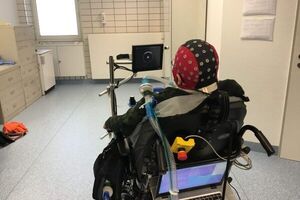
Brain-Powered Wheelchair Shows Real-World Promise
"In one of the first studies of its kind, several people with motor disabilities were able to operate a wheelchair that translates their thoughts into movement. The study by researchers at The University of Texas at Austin and published today in the journal iScience is an important step forward for brain-machine interfaces — computer systems that turn mind activity into action. The concept of a thought-powered wheelchair has been studied for years, but most projects have used non-disabled subjects or stimuli that leads the device to more or less control the person rather than the other way around. In this case, three individuals with tetraplegia, the inability to move their arms and legs due to spinal injuries, operated the wheelchair in a cluttered, natural environment to varying degrees of success. The interface recorded their brain activity, and a machine-learning algorithim translated it into commands that drove the wheelchair. The researchers said this is a sign of future commercial viability for mind-powered wheelchairs that can assist people with limited motor function." [...]

A Radical New Approach in Synthetic Chemistry
"Pulse radiolysis experiments help reveal how unpaired electrons at one end of a molecule can initiate chemistry at 'distant' locations Scientists at the U.S. Department of Energy’s (DOE) Brookhaven National Laboratory helped measure how unpaired electrons in atoms at one end of a molecule can drive chemical reactivity on the molecule’s opposite side. As described in a paper recently published in the Journal of the American Chemical Society, this work, done in collaboration with Princeton University, shows how molecules containing these so-called free radicals could be used in a whole new class of reactions. “Most reactions involving free radicals take place at the site of the unpaired electron,” explained Brookhaven Lab chemist Matthew Bird, one of the co-corresponding authors on the paper. The Princeton team had become experts in using free radicals for a range of synthetic applications, such as polymer upcycling. But they’ve wondered whether free radicals might influence reactivity on other parts of the molecule as well, by pulling electrons away from those more distant locations. “Our measurements show that these radicals can exert powerful ‘electron-withdrawing’ effects that make other parts of the molecule more reactive,” Bird said." [...]

Catching the dynamic Coronal Web
"Researchers discover an important clue as to what mechanism drives the solar wind Using observational data from the U.S. weather satellites GOES, a team of researchers led by the Max Planck Institute for Solar System Research (MPS) in Germany has taken an important step toward unlocking one of the Sun’s most persevering secrets: How does our star launch the particles constituting the solar wind into space? The data provide a unique view of a key region in the solar corona to which researchers have had little access so far. There, the team has for the first time captured a dynamic web-like network of elongated, interwoven plasma structures. Together with data from other space probes and extensive computer simulations, a clear picture emerges: where the elongated coronal web structures interact, magnetic energy is discharged - and particles escape into space. The Geostationary Operational Environmental Satellites (GOES) of the U.S. National Oceanic and Atmospheric Administration (NOAA) have traditionally concerned themselves with other things than the Sun. Since 1974, the system has been orbiting our planet at an altitude of about 36000 kilometers and continuously providing Earth-related data for example for weather and storm forecasting." [...]

New collaboration to probe physical reality’s quantum ‘glue’
"An ambitious new collaboration promises to expand our understanding of what some physicists have called the “glue” that holds the universe together — the strong nuclear force. “One of the fundamental forces of nature is the strong nuclear force,” said Igor Klebanov, Eugene Higgins professor of physics at Princeton University, a 1986 Ph.D. alumnus, the director of the collaboration and a leading expert in the field of physics. “Without the strong force, there would be no life as we know it.” The collaboration, which began in early September, is being funded by the New York-based Simons Foundation — a private foundation created in 1994 that is one of the nation’s largest charitable science-oriented organizations. For nearly 30 years, the Simons Foundation has been dedicated to funding fundamental research on everything from nuclear fusion and condensed matter physics to abstract mathematics. “The Simons Foundation has been playing an increasingly powerful role in funding science in the U.S. and beyond,” Klebanov said. “In particular, they have a very vigorous program of funding fundamental physics.” The Simons Collaboration on Confinement and QCD Strings, so named because it explores the theory of the strong nuclear force known as quantum chromodynamics (QCD), includes 13 principal investigators from the United States, Italy, Switzerland, Israel and the United Kingdom." [...]
Simple semiconductor solutions could boost solar energy generation and enable better space probes
"A 'simple' tweak to perovskite solar cells during the fabrication stage could help to unlock the untold potential of the renewable energy source, claims research from the University of Surrey. Surrey's Advanced Technology Institute (ATI) has demonstrated that by precisely controlling the fabrication process, it is possible to regulate and reduce unwanted energy loss in perovskite solar panels. Dr Bowei Li, a lead researcher of the programme at the Advanced Technology Institute, University of Surrey, said: "The future of perovskite solar panels is incredibly exciting, with the promise of not only improving the performance of solar farms and roof panels but many opportunities in powering spacecraft and interstellar probes. "We hope the relatively straightforward approach demonstrated in our study, which tackles recombination losses, can improve the reproducibility, efficiency and stability of perovskite solar cells." Perovskite solar cells are widely considered the natural successor to silicon-based solar devices because of their high energy conversion efficiency, low development cost, and lightweight nature. Named after a naturally occurring mineral with a structurally similar chemical formula, perovskites are synthetic composites with three-dimensional lattice crystal structures." [...]
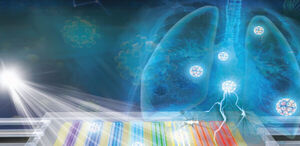
Reflecting on a shift in "rainbow" sensors
"Nanostructured surfaces enable lab-on-a-chip lung cancer diagnosis. A miniaturized plasmonic spectrometer that creates a rainbow pattern that shifts in the presence of a chemical or biological sample has been developed. Crucially, these spectral shifts can be observed in a standard optical microscope. For a beam of light to be able to interact with its surroundings, the smallest length scale is roughly equivalent to half of its wavelength. It is this principle that sets the fundamental restriction on the maximum resolution imaging optics, such as microscopes or spectrometers, can achieve. But this limit can be surpassed using plasmonics." [...]
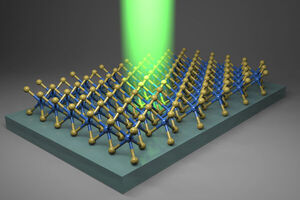
How “2D” materials expand
"A new technique that accurately measures how atom-thin materials expand when heated could help engineers develop faster, more powerful electronic devices. Two-dimensional materials, which consist of just a single layer of atoms, can be packed together more densely than conventional materials, so they could be used to make transistors, solar cells, LEDs, and other devices that run faster and perform better. One issue holding back these next-generation electronics is the heat they generate when in use. Conventional electronics typically reach about 80 degrees Celsius, but the materials in 2D devices are packed so densely in such a small area that the devices can become twice as hot. This temperature increase can damage the device. This problem is compounded by the fact that scientists don’t have a good understanding of how 2D materials expand when temperatures rise." [...]

‘Butterfly Bot’ is Fastest Swimming Soft Robot Yet
"Inspired by the biomechanics of the manta ray, researchers at North Carolina State University have developed an energy-efficient soft robot that can swim more than four times faster than previous swimming soft robots. The robots are called “butterfly bots,” because their swimming motion resembles the way a person’s arms move when they are swimming the butterfly stroke. “To date, swimming soft robots have not been able to swim faster than one body length per second, but marine animals – such as manta rays – are able to swim much faster, and much more efficiently,” says Jie Yin, corresponding author of a paper on the work and an associate professor of mechanical and aerospace engineering at NC State. “We wanted to draw on the biomechanics of these animals to see if we could develop faster, more energy-efficient soft robots. The prototypes we’ve developed work exceptionally well.” The researchers developed two types of butterfly bots. One was built specifically for speed, and was able to reach average speeds of 3.74 body lengths per second." [...]

Simple hardware to defend microgrid attacks
"An inexpensive piece of hardware integrated with solar panel controllers can protect isolated power networks from cyberattacks. One advantage of small-scale renewable energy systems is that they can be arranged into networks that operate independently of the main electric grid when required. Now, researchers at KAUST are developing ingenious ways of protecting these networks, known as microgrids, from cyberattacks. “Microgrids are small ‘power islands’ that can provide electricity for critical services, such as healthcare, food and water, during emergencies,” explains Ioannis Zografopoulos, who conducted the research with Charalambos Konstantinou at KAUST and co-workers at the University of Texas at Dallas, U.S. However, the relative simplicity and isolation of microgrids makes them attractive targets for cyberattacks aimed at disrupting communities. In their latest efforts to improve microgrid security, the team employed hardware performance counters (HPCs) — special registers that are embedded within most computers to monitor events, such as how many times a certain command has been performed." [...]

A simpler path to better computer vision
"New research reveals a scalable technique that uses synthetic data to improve the accuracy of AI models that recognize images. Before a machine-learning model can complete a task, such as identifying cancer in medical images, the model must be trained. Training image classification models typically involves showing the model millions of example images gathered into a massive dataset. However, using real image data can raise practical and ethical concerns: The images could run afoul of copyright laws, violate people’s privacy, or be biased against a certain racial or ethnic group. To avoid these pitfalls, researchers can use image generation programs to create synthetic data for model training. But these techniques are limited because expert knowledge is often needed to hand-design an image generation program that can create effective training data." [...]

Electron pairing in quantum dots as new approach to qubit research
"Publication in Nature demonstrates promising method towards building the foundation for a future quantum computer. Scientists from QuTech and Eindhoven University of Technology have taken a next step in qubit research. Qubits are one of the building blocks of a future quantum computer. The researchers - including Sasa Gazibegovic, Ghada Badawy and Erik Bakkers from TU/e - have published their results in Nature on 23 November 2022. A conventional computer performs operations using bits, which can be either zero or one. A quantum computer, on the other hand, uses quantum bits or ‘qubits’." [...]

A far-sighted approach to machine learning
"New system can teach a group of cooperative or competitive AI agents to find an optimal long-term solution. Picture two teams squaring off on a football field. The players can cooperate to achieve an objective, and compete against other players with conflicting interests. That’s how the game works. Creating artificial intelligence agents that can learn to compete and cooperate as effectively as humans remains a thorny problem. A key challenge is enabling AI agents to anticipate future behaviors of other agents when they are all learning simultaneously." [...]
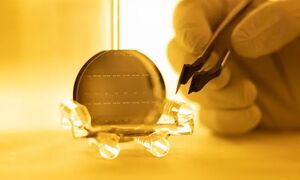
Leveraging Ethics to Make Quantum Research Sustainable
"Innsbruck is a leading center in the development of new quantum technologies. In order to understand the processes of societal change triggered by these technologies and to be able to develop corresponding ethics frameworks, the University of Innsbruck is founding today the Innsbruck Quantum Ethics Lab (IQEL), in which experts from various disciplines will work together. The innovation potential associated with quantum technologies can trigger processes of social change. For this reason, new technical developments must always be scrutinized for their effects on people and society and founded on ethics. At the same time, the freedom to innovate must be preserved. "In this area of tension, the Innsbruck Quantum Ethics Lab aims to create added value for society," says IQEL director and digital law expert Matthias C. Kettemann, head of the Department for Theory and Future of Law." [...]
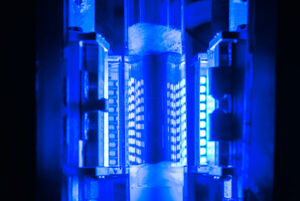
Rice lab’s catalyst could be key for hydrogen economy
"Inexpensive catalyst uses energy from light to turn ammonia into hydrogen fuel Rice University researchers have engineered a key light-activated nanomaterial for the hydrogen economy. Using only inexpensive raw materials, a team from Rice’s Laboratory for Nanophotonics, Syzygy Plasmonics Inc. and Princeton University’s Andlinger Center for Energy and the Environment created a scalable catalyst that needs only the power of light to convert ammonia into clean-burning hydrogen fuel. The research is published online today in the journal Science. The research follows government and industry investment to create infrastructure and markets for carbon-free liquid ammonia fuel that will not contribute to greenhouse warming. Liquid ammonia is easy to transport and packs a lot of energy, with one nitrogen and three hydrogen atoms per molecule. The new catalyst breaks those molecules into hydrogen gas, a clean-burning fuel, and nitrogen gas, the largest component of Earth’s atmosphere." [...]
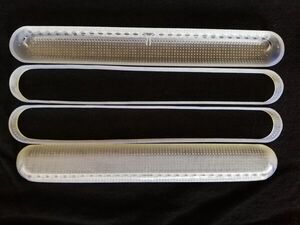
Glass-like shells of diatoms help turn light into energy in dim conditions
"Information gleaned from the optical analysis of diatom shells might one day improve a variety of light-based devices and components A new study has revealed how the glass-like shells of diatoms help these microscopic organisms perform photosynthesis in dim conditions. A better understanding of how these phytoplankton harvest and interact with light could lead to improved solar cells, sensing devices and optical components. “The computational model and toolkit we developed could pave the way toward mass-manufacturable, sustainable optical devices and more efficient light harvesting tools that are based on diatom shells,” said research team member Santiago Bernal from McGill University in Canada. “This could be used for biomimetic devices for sensing, new telecommunications technologies or affordable ways to make clean energy.” Diatoms are single-celled organisms found in most bodies of water. Their shells are covered in holes that respond to light differently depending on their size, spacing and configuration. In the journal Optical Materials Express, the researchers, led by McGill University’s David V. Plant and Mark Andrews, report the first optical study of an entire diatom shell." [...]

Achieving a quantum fiber
"Researchers from ICFO, Corning Incorporated, Micro Photon Devices, and Politecnico di Milano successfully demonstrate the transport of two-photon quantum states of light through a phase-separated Anderson localization optical fiber. Invented in 1970 by Corning Incorporated, low-loss optical fiber became the best means to efficiently transport information from one place to another over long distances without loss of information. The most common way of data transmission nowadays is through conventional optical fibers - one single core channel transmits the information. With the exponential increase of data generation, these systems are reaching information-carrying capacity limits. Thus, research now focuses on finding new ways to utilize the full potential of fibers by examining their inner structure and applying new approaches to signal generation and transmission. Moreover, applications in quantum technology are enabled by extending this research from classical to quantum light." [...]
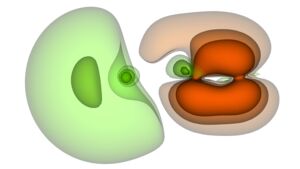
Quantum algorithms save time in the calculation of electron dynamics
"Quantum computers promise significantly shorter computing times for complex problems. But there are still only a few quantum computers worldwide with a limited number of so-called qubits. However, quantum computer algorithms can already run on conventional servers that simulate a quantum computer. A team at HZB has succeeded to calculate the electron orbitals and their dynamic development on the example of a small molecule after a laser pulse excitation. In principle, the method is also suitable for investigating larger molecules that cannot be calculated using conventional methods. "These quantum computer algorithms were originally developed in a completely different context." [...]

Teaching photonic chips to learn
"A multi-institution research team has developed an optical chip that can train machine learning hardware. Machine learning applications skyrocketed to $165B annually, according to a recent report from McKinsey. But, before a machine can perform intelligence tasks such as recognizing the details of an image, it must be trained. Training of modern-day artificial intelligence (AI) systems like Tesla's autopilot costs several million dollars in electric power consumption and requires supercomputer-like infrastructure. This surging AI "appetite" leaves an ever-widening gap between computer hardware and demand for AI. Photonic integrated circuits, or simply optical chips, have emerged as a possible solution to deliver higher computing performance, as measured by the number of operations performed per second per watt used, or TOPS/W." [...]
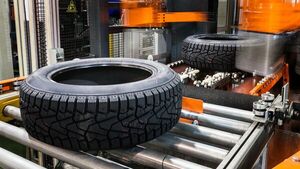
Unraveling the secrets of microplastics released by tires
"In Switzerland, tire and road wear particles are one of the biggest sources of microplastics released into the environment, yet the chemical compounds contained in those particles – and their effects – remain largely a mystery. To remedy that knowledge gap, scientists at EPFL and two other Swiss research institutes are conducting a study of the toxicity of tire-particle compounds and how readily they’re absorbed by living organisms. The first phase of the study has just been completed. The study, which kicked off in April 2020, is being sponsored by a consortium of leading tire manufacturers. The two other research institutes working with EPFL are the Swiss Centre for Applied Ecotoxicology (Ecotox Centre), which is coordinating the project, and the Swiss Federal Institute of Aquatic Science and Technology (Eawag). The first phase concluded with two papers published in Environmental Science & Technology (in late November 2021 and late October 2022)." [...]

Pushing the Boundaries of Fluid Equations
"The motion of fluids in nature, including the flow of water in our oceans, the formation of tornadoes in our atmosphere, and the flux of air surrounding airplanes, have long been described and simulated by what are known as the Navier–Stokes equations. Yet, mathematicians do not have a complete understanding of these equations. While they are a useful tool for predicting the flow of fluids, we still do not know if they accurately describe fluids in all possible scenarios. This led the Clay Mathematics Institute of New Hampshire to label the Navier–Stokes equations as one of its seven Millennium Problems: the seven most pressing unsolved problems in all of mathematics. The Navier–Stokes Equation Millennium Problem asks mathematicians to prove whether "smooth" solutions always exist for the Navier–Stokes equations. Put simply, smoothness refers to whether equations of this type behave in a predictable way that makes sense." [...]

Mathematics works in serendipitous ways
"A theorem developed by Queen’s professor Ernst Kani was used to crack an encryption algorithm in an US government test. In the digital era and moving towards quantum computing, protecting data against hack attacks is one of our biggest challenges – and one that experts, governments, and industries worldwide work hard to address. While this is an effort to build a more connected and safe future, it can certainly learn from the past. In July, the US National Institute of Standards and Technology (NIST) selected four encryption algorithms and posed some challenge problems to test their security, offering a $50,000 reward for whomever managed to break them. It happened in less than an hour: one of the promising algorithm candidates, named SIKE, was hacked with a single personal computer. The attack did not rely on a powerful machine, but on powerful mathematics based on a theorem developed by a Queen’s professor decades ago." [...]
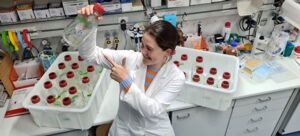
Breaking nitrogen while generating methane
"Scientists have successfully enhanced cultivation of a microorganism that can fix nitrogen (N2) while producing methane (CH4) and ammonia (NH3) and investigated exciting details of its metabolism. Carbon and nitrogen are essential elements of life. Some organisms take up key positions for the cycling of both of them -- among them Methanothermococcus thermolithotrophicus. Behind the complicated name hides a complicated microbe. M. thermolithotrophicus is a marine heat-loving methanogen. It lives in ocean sediments, from sandy coasts and salty marshes to the deep-sea, preferably at temperatures around 65 °C." [...]

First 100% bio-based 3D-printed home unveiled at the University of Maine
"On Nov. 21, the University of Maine Advanced Structures and Composites Center (ASCC) unveiled BioHome3D, the first 3D-printed house made entirely with bio-based materials. BioHome3D was developed with funding from the U.S. Department of Energy’s Hub and Spoke program between the UMaine and Oak Ridge National Laboratory. Partners included MaineHousing and the Maine Technology Institute. The 600-square-foot prototype features 3D-printed floors, walls and roof of wood fibers and bio-resins. The house is fully recyclable and highly insulated with 100% wood insulation and customizable R-values. Construction waste was nearly eliminated due to the precision of the printing process." [...]
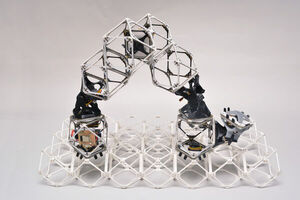
Flocks of assembler robots show potential for making larger structures
"Researchers make progress toward groups of robots that could build almost anything, including buildings, vehicles, and even bigger robots. Researchers at MIT have made significant steps toward creating robots that could practically and economically assemble nearly anything, including things much larger than themselves, from vehicles to buildings to larger robots. The new work, from MIT’s Center for Bits and Atoms (CBA), builds on years of research, including recent studies demonstrating that objects such as a deformable airplane wing and a functional racing car could be assembled from tiny identical lightweight pieces — and that robotic devices could be built to carry out some of this assembly work. Now, the team has shown that both the assembler bots and the components of the structure being built can all be made of the same subunits, and the robots can move independently in large numbers to accomplish large-scale assemblies quickly. The new work is reported in the journal Nature Communications Engineering, in a paper by CBA doctoral student Amira Abdel-Rahman, Professor and CBA Director Neil Gershenfeld, and three others. A fully autonomous self-replicating robot assembly system capable of both assembling larger structures, including larger robots, and planning the best construction sequence is still years away, Gershenfeld says." [...]
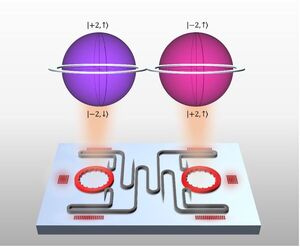
Microlaser Chip Adds New Dimensions to Quantum Communication
"Researchers at Penn Engineering have created a chip that outstrips the security and robustness of existing quantum communications hardware. Their technology communicates in “qudits,” doubling the quantum information space of any previous on-chip laser. Liang Feng, Professor in the Departments of Materials Science and Engineering (MSE) and Electrical Systems and Engineering (ESE), along with MSE postdoctoral fellow Zhifeng Zhang and ESE Ph.D. student Haoqi Zhao, debuted the technology in a recent study published in Nature. The group worked in collaboration with scientists from the Polytechnic University of Milan, the Institute for Cross-Disciplinary Physics and Complex Systems, Duke University and the City University of New York (CUNY). Bits, Qubits and Qudits While non-quantum chips store, transmit and compute data using bits, state-of-the-art quantum devices use qubits. Bits can be 1s or 0s, while qubits are units of digital information capable of being both 1 and 0 at the same time." [...]

New quantum tool developed in groundbreaking experimental achievement
"For the first time in experimental history, researchers at the Institute for Quantum Computing (IQC) have created a device that generates twisted neutrons with well-defined orbital angular momentum. Previously considered an impossibility, this groundbreaking scientific accomplishment provides a brand new avenue for researchers to study the development of next-generation quantum materials with applications ranging from quantum computing to identifying and solving new problems in fundamental physics. “Neutrons are a powerful probe for the characterization of emerging quantum materials because they have several unique features,” said Dr. Dusan Sarenac, research associate with IQC and technical lead, Transformative Quantum Technologies at the University of Waterloo. “They have nanometer-sized wavelengths, electrical neutrality, and a relatively large mass. These features mean neutrons can pass through materials that X-rays and light cannot.” While methods for the experimental production and analysis of orbital angular momentum in photons and electrons are well-studied, a device design using neutrons has never been demonstrated until now. Because of their distinct characteristics, the researchers had to construct new devices and create novel methods for working with neutrons." [...]

A possible game changer for next generation microelectronics
"Tiny magnetic whirlpools could transform memory storage in high performance computers. Magnets generate invisible fields that attract certain materials. A common example is fridge magnets. Far more important to our everyday lives, magnets also can store data in computers. Exploiting the direction of the magnetic field (say, up or down), microscopic bar magnets each can store one bit of memory as a zero or a one — the language of computers. Scientists at the U.S. Department of Energy’s (DOE) Argonne National Laboratory want to replace the bar magnets with tiny magnetic vortices." [...]

Engineers solve a mystery on the path to smaller, lighter batteries
"Branchlike metallic filaments can sap the power of solid-state lithium batteries. A new study explains how they form and how to divert them. A discovery by MIT researchers could finally unlock the door to the design of a new kind of rechargeable lithium battery that is more lightweight, compact, and safe than current versions, and that has been pursued by labs around the world for years. The key to this potential leap in battery technology is replacing the liquid electrolyte that sits between the positive and negative electrodes with a much thinner, lighter layer of solid ceramic material, and replacing one of the electrodes with solid lithium metal. This would greatly reduce the overall size and weight of the battery and remove the safety risk associated with liquid electrolytes, which are flammable. But that quest has been beset with one big problem: dendrites." [...]

Scientists use carbon to detect a new nitrogen source in the open ocean
"Lawrence Livermore National Laboratory (LLNL) and UC Santa Cruz scientists have detected a previously hypothesized class of nitrogen fixation in the surface ocean. Nitrogen scarcity limits the growth of ocean phytoplankton, a globally important carbon sink and the base of the marine food web. Nitrogen that can be used by phytoplankton generally has a very low concentration in the sunlit layer of the open ocean, but the two primary sources of new nitrogen in the surface oceans are nitrate coming up from the deep, and biological nitrogen “fixation” of N2 gas from the atmosphere by some cyanobacteria. In new research published in Nature Communications, the team found that an alternative class of nitrogen fixers, which are not photosynthetic, are associated with marine particles and fix nitrogen in some parts of the ocean. “For over three decades, scientists have known this alternative class of nitrogen-fixing organism is widespread in the surface oceans, but we lacked direct evidence that they can actually fix nitrogen until now,” said lead author and former LLNL graduate scholar Katie Harding. Harding was a graduate student at UC Santa Cruz in the laboratory of Jonathan Zehr, who has spent decades studying marine nitrogen fixation." [...]

Cosmic chocolate pralines: general neutron star structure revealed
"Through extensive model calculations, physicists at Goethe University Frankfurt have reached general conclusions about the internal structure of neutron stars, where matter reaches enormous densities: depending on their mass, the stars can have a core that is either very stiff or very soft. The findings were published simultaneously in two articles today. So far, little is known about the interior of neutron stars, those extremely compact objects that can form after the death of a star: the mass of our sun or even more is compressed into a sphere with the diameter of a large city. Since their discovery more than 60 years ago, scientists have been trying to decipher their structure. The greatest challenge is to simulate the extreme conditions inside neutron stars, as they can hardly be recreated on Earth in the laboratory. There are therefore many models in which various properties – from density and temperature – are described with the help of so-called equations of state." [...]
Documentação
A documentação é parte essencial do processo de aprendizagem e a Internet além de artigos interessantes de explorar também tem alguma documentação em formato PDF interessante de ler. Todos os links aqui apresentados são para conteúdo disponibilizado livremente pelo editor do livro.
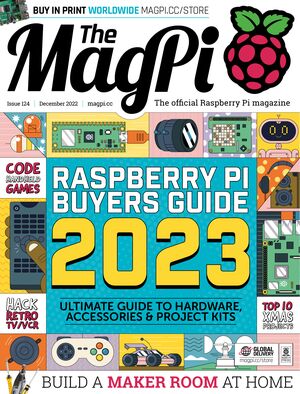
The MagPi 124
"Inside The MagPi magazine issue #124 - Raspberry Pi Buyers Guide 2023: Your ultimate guide to hardware, accessories and project kits. - Create your own maker space: build a haven in your home for making - Hack a CRT TV & VCR: give a classic television combo modern smarts with Raspberry Pi - Make a game in MicroPython: program a tiny survival game for Pico - 10 amazing holiday projects: last-minute ideas for the festive season Win! A MicroPi Starter Kit: we love this robotics and computer kit" [...]
Projetos Maker
Diversos Projetos interessantes.

Where'sLy Clock Project
"This project contains all the work I have done so far on creating a working GPS driven clock that emulates the Magical Clock from the Harry Potter films. I spent months on this and you are free to download the project, its on an MIT open source licence. If you have trouble drop an incident. If you feel you could contribute to the project, let me know, I have no idea how to organise that, yet, but taking suggestions. Background About four years ago, having watched a Harry Potter film. I knew; I could make that." [...]
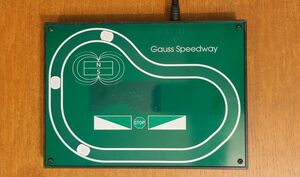
The Gauss Speedway
"Here's a fun toy project I finally finished this month (Nov '22). It's a racetrack built with a printed circuit board, and small 3D printed magnetic cars. They just drive around the circuit when you apply (the right) current! That's it! That's the project! History It started from a conversation with Kevin Lynagh, who did some experiments1 with moving magnets around a 2D grid with wires running both directions, which planted the idea of a racetrack version in my head." [...]

Simple Indoor VOCs Detection and Alarm System
"By utilizing the Seeed Studio hardware and Azure IoT Central, we could build a simple indoor VOC detection and alarm system. Motivation VOCs (Volatile Organic Compounds) are responsible for the odor of scents, perfumes, and contaminants. Anthropogenic VOCs are legally restricted, particularly indoors, where concentrations are highest. Though most VOCs are not acutely hazardous, some of them may be harmful to human health or the environment and thereby cause long-term health consequences. Main sources of volatile organic compounds: Outdoor: mainly from the industrial waste gas, automobile exhaust gas, and photochemical pollution generated by fuel combustion and transportation; Indoor: mainly comes from burning products such as coal and natural gas, smoking, heating and cooking, building and decoration materials, furniture, household appliances, cleaners, and emissions from the human body. In the interior decoration process, volatile organic compounds mainly come from paint, coat, and adhesives." [...]

Termi2 - a Typewriter That Answers Your Questions
"What if a typewriter could respond to questions you enter? I answered that question several years ago with a project I called Termi. I salvaged a vintage TI Silent 700 electric typewriter/terminal (Model 745) and connected it to a Raspberry Pi Zero W that ran a script to query Wolfram Alpha. When the user typed a question into the typewriter, it would type out the answer ...like a 1976 version of Siri. For example, a simple exchange might look like: Question: who is the president of the United States? Answer: the current president of the United States is Joe Biden Termi2 is a reimagined version of that project, but better." [...]
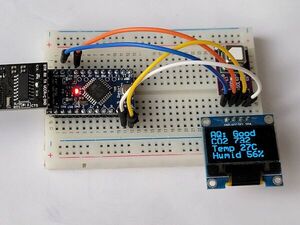
The "CO2" Project
"Environmental sensing and air quality have always been fascinating to study. I've tested various sensors over the years that, until recently, cost next to nothing. The COVID pandemic increased my curiosity (and concern) about indoor air quality, CO2 levels, and shared air. In the past, I tried to save some money and use the "eCO2" value from several inexpensive sensors, but the results were unreliable and unsatisfying. eCO2 is an "equivalent CO2" value generated by some VOC (volatile organic compound) sensors. The idea is that human breath contains lots of VOCs and if you detect them, you're also detecting CO2." [...]

Nixie Display Module With SPI Interface
"Overview: So there are plenty of display modules available to work with an SPI bus, mostly based around LED or LCD technology. But I wanted to re-use some old Nixie teck. This Instructable is what I came up with. The completed module is compact and fairly robust so I don't need to worry about it getting knocked around on my workbench, and its a simple task to re-use the display module with multiple projects. Features: 4 circuit boards simplifies construction and testing. PIC16F15344 Micro-Controller - 32MHz with internal SPI bus." [...]

DIY Sports Push Buttons - Based on ESP32-C3
"Here I made four sports push buttons with arcade buttons using DFRobot Beetle ESP32-C3. Story Push buttons, also known as tactile switches, can be found everywhere from simple lamps, and doorbells to large industrial machines. There are so many kinds of push buttons, but I like the arcade push buttons most because they usually have a great tactile, "clicky” feel. I have several arcade buttons in my toolbox, and I always want to make something with them. Lately, I've been working out. One day an idea comes to my mind, can I turn my arcade buttons into a device that helps me do sports?" [...]
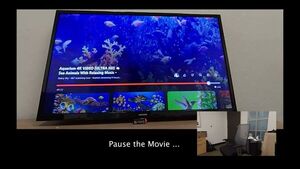
Auto-pause your TV
"Tired of rummaging for your remote every time you get up from the couch? This Arduino project pauses and plays your TV automagically! I'm often tired when I sit down to watch TV at the end of a day, so I want the experience to be as easy as possible. One simple improvement I've dreamt about is having the TV notice when I've got up so it can automatically pause the current show, and then resume it when I return. I decided to prototype this using one of our Person Sensors, together with a Circuit Playground Express board from Adafruit. This guide will show you how to build one too, with no soldering required!" [...]

HC-05 Bluetooth With Raspberry Pi Pico Using Micropython
"This guide covers how to use the HC-05 Bluetooth module with a Raspberry Pi Pico board using MicroPython. The HC-05 is a Bluetooth module that can be used to wirelessly communicate with other Bluetooth devices, such as smartphones, laptops, and other microcontrollers. You need to ensure that you have the following components below before going through this tutorial. Raspberry Pi Pico HC05 Bluetooth Module Jumper Wire Breadboard" [...]
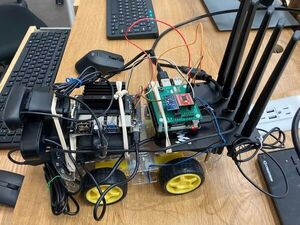
RoboCar: 5G Cellular Remote Driving Robot
"A remote-driving intelligent robot car based on IoT oneM2M techniques Introduction In this project, we are going to build a remote-driving intelligent robot car using single-board computers combined with IoT oneM2M techniques.The car can be controlled by a remote driver through the WiFi or 5G network and sends the camera view as well as the AI-recognized road status information back to the remote user. We will program on single-board computers, such as Raspberry Pi 4 and NVIDIA Jetson, and develop a remote control system for the robot car. The control system will be built on 5G/LTE IoT networks and AWS/GCP platforms using oneM2M and real-time communication protocols.We will also develop a road status recognition module based on computer vision techniques to assist remote users to take necessary action in real-time.The challenges in this project are: Developing a control system over multiple devices/platforms including embedded devices, cloud computing platforms, and desktop computers. Developing a oneM2M and real-time communication solution via 5G IoT networks and the Internet. Developing a computer vision model on a resource-limited embedded device. About this project, you can find the source code in this GitHub repository and more information on the project page." [...]
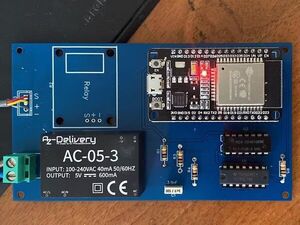
Home Assistant Deep BLE Relay-Low energy
"BLE relay device for Home Assistant that, for the most of time is in a very low energy state and only a few seconds per minute is awake. The purpose of this project, was to develope a BLE relay device for Home Assistant that, for the most of time, was in a very low energy and emission state and only for few seconds per minute was in awake state. At the same time I didn’t need that my ON/Off remote commands was executed instantaneously but, for my needs, was enough that every ON/Off command was really executed within a time interval of one minute. In other words, for my needs (i.e. to start and stop an aged fan coil unit), it's really unimportant that there is a time delay of at most one minute between the press of the button on the Home Assistant’s dashboard and the effective change of the relay state (that turn off or turn on the fan coil unit). The project is entirely based on two ESP32 boards, the first acting as a remote BLE server and the second, integrated on the HA platform, acting as BLE client." [...]

Nano_Vaders
"Space Invaders for the Nano Every using a 2.7" OLED Display There are a few Space Invader games available for Arduino. I got motivated to try and improve on the current ones. I wanted to use a larger screen so I decided to use a 2.7 Inch OLED. I increased the number of Rows and Columns to match the Original Taito Space Invaders. I have added a FPS display so you can see what it's running at. I decided to use the Nano Every as I needed the Extra Ram for the extra aliens on the screen." [...]

Build a 64kB home computer based on an Arduino Mega 256
"This is another retro compute project. Use an Arduino Mega256, 64kB serial RAM, a display and a keypad to build a standalone computer. The idea I had the idea to build a standalone computer resembling the old ZX81 computer when I first save that the ZX81 keyboards are still for sale at a reasonable price. Some call them the worst keyboard ever. The old ZX81 home computer was a super low cost machine. I never had one back then but friends of mine did." [...]

Android Robot Head Hardware
"This Instructable describes how to build an android head. It uses an Arduino Nano as a servo controller. When I visited an exhibition of robots at our local museum, one of the most popular exhibits was a robot head that tracked people's faces and tried to copy their expressions (maybe this one). I wondered how it worked and whether I could do something similar. When you build a humanoid robot head, it's hard to know where to start. I looked at other examples and couldn't work out how their chassis was built or how the actuators were attached." [...]
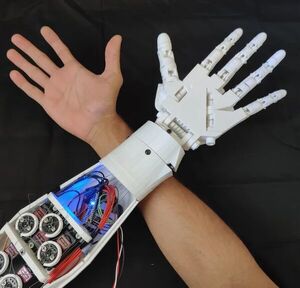
3D Printed EMG Prosthetic Hand
"If you've ever looked at prices for prosthetic arms, you may have noticed that they can cost upwards of $5000, with more advanced myoelectric controlled arms priced at over $20,000. Such prices are not ideal considering that over 80 percent of amputees are from developing countries where access to prosthetic limbs is limited by lack of health care and financial resources. With 3D printing, however, we can create more cost-effective prosthetics that can better address the need of amputees. Some of the major advantages of 3D printing are rapid prototyping, customization of size, and the flexibility to replace parts by printing new ones. This project combines a 3D printed robotic arm from an open source project called InMoov with an Arduino compatible muscle sensor from Advancer Technologies. While this arm may not be as advanced as a $20,000 prosthetic limb, it is still a proof of concept that demonstrates the possibility of creating cost effective limbs that can provide comparable functionality at a fraction of the price." [...]

Handheld BOT
"I am very found of making robots and wanted to gift one to my cousin who is just 7 years old. There are many robots on the Internet, I wanted to make a robot which would easily fit in my hand, and the design should be appealing to the child. I wanted to keep everything simple, so I went with a circular shape design like to 3PI Robot. I really liked to 3PI Bot design and wanted to make something similar. So, without further adieu let's get started. Supplies The Main Items necessary for the BOT are: - 3D Printer (optional) - 9V/1 Adapter x1 for charging the robot - 18650 Batteries x2 - 18650 for 2 Battery Holder x1 - N20 Gear Motor with Bracket Holders x2 - N20 Gear Motor Wheels x2 - Arduino Pro Mini x1 - FTDI Module (This is for Programming the Arduino Pro Mini) - DRV8833 Adafruit Module x1 - 5V Buzzer x1 - RN42 Bluetooth Module (you can also use HC05/HC06) - BQ24005 IC x1 - Multi-color Flashing LEDs x6 - etc." [...]
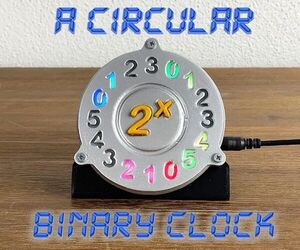
A Circular Binary Clock
"In a previous instructable, I have presented a concept for making a “linear” binary clock from a standard WS2812 LED strip and an ATtiny microprocessor. The design of that clock was not that great… …which is why I made a new version using an LED ring. This clock will show the hours, minutes, and seconds of the current time in a binary style on the 16 LEDs of the ring - 4 representing the hours (blue), 6 representing the minutes (pink) and 6 representing the seconds (green). You will get the correct time, if you just add the single 2x values of each LED. As an example, it is 11:36:49 a.m. in the picture above. Hence, the clock lights the blue LEDs “0”, “1”, and “3” for the hours (= 20 + 21 + 23 = 1 + 2 + 8 = 11)." [...]
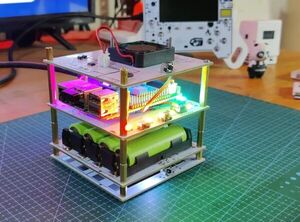
Sandwich Dot IO
"Hey everyone, what's up? So here's something super interesting and cool: SANDWICH DOT IO. It's a Raspberry Pi system with onboard power, a dedicated cooling layer, and even RGB LEDs for aesthetics. This setup was created to address a problem I encountered while working on a Raspberry Pi-based project: I wanted to create a small game emulator using the RPI 3B+, but the problem was the power supply. A 5V adaptor was used for powering the Raspberry Pi. A fan was also required to keep the Pi cool, but I had to add another 5V supply for it as we cannot plug it directly into the 5V of the Raspberry Pi." [...]

Hollow Clock 4
"New version of the Hollow Clock is released. Contrary to the former version (Hollow Clock 3), the angle of the hour hand is controlled not mechanically but magnetically. Very easy to adjust the time. Supplies: - Three 8mm x 3mm neodymium (neodym) magnets - 28BYJ-48 stepper motor and its driver board - Arduino nano - 2mm tapping screws (short : 5, long : 1)" [...]
Secção Videos
Videos interessantes.
That's all Folks!





